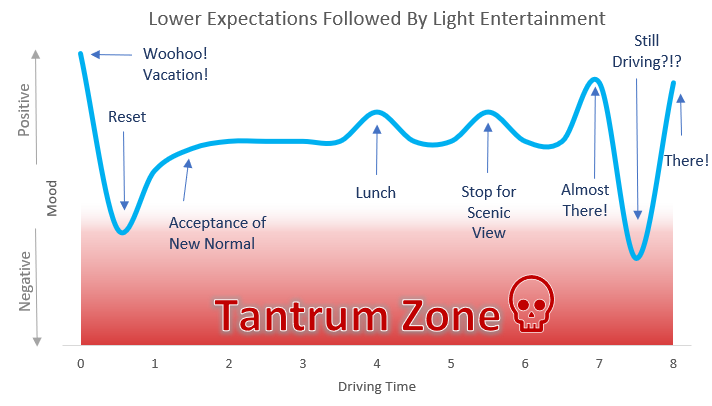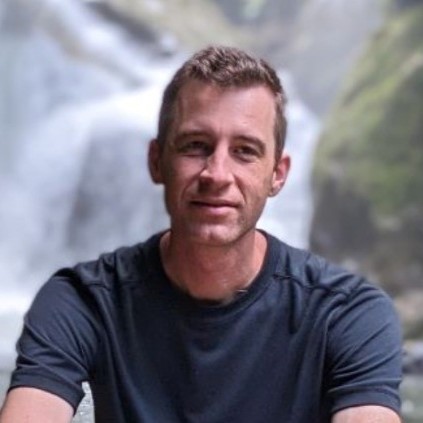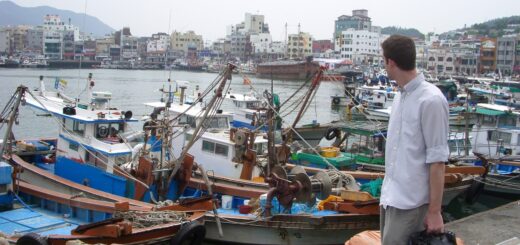Driving with Kids Scary? Try This Counterintuitive Approach

A long drive with kids can be intimidating. The go-to approach is to manage the chaos with games, snacks, and screen time. In other words, distraction by entertainment. But what if more entertainment is actually the problem, not the solution?
Intimidated by The Long Drive
Contemplating a long haul drive with little kids is daunting. The whining. The meltdowns. The need to pee every twenty minutes. It might just be enough to dissuade you from an otherwise tantalizing getaway.
We know. We have three little boys: two, four and seven. And whenever our itinerary involves lots of driving, we hesitate. So what is a young vagabonding family to do?
We recently took an epic road trip from Chicago to the Olympic Peninsula in Washington. We spent seven of the sixteen days enduring marathon driving sessions. Some days we spent up to twelve hours in the car. We were definitely hesitant. But the price of flights (times five) and a stop at Glacier National Park along the way convinced us to go for it. And I’m happy to report, the boys did very well!
Though possibly the most ambitious, this wasn’t the first long road trip we’ve taken. Hours long sobbing jags and prickly tantrums are a pain point for us.
Searching for advice on how to have a quiet car ride with kids returns listicles of games, toys, snacks, and audio books to keep them stimulated.
But what if stimulation is actually the problem, not the solution?
I’m not suggesting you don’t bring things to do. You will need them (along with a big plastic cup for when they have to pee every twenty minutes). But I will argue in this article that you should use them at certain times and resist them at others.
The “method” I suggest here hasn’t been proven in some mass experiment. I can only vouch for my own experience. However, I will make my case with psychological insights on how emotions work.
That said, I offer this advice as nothing more than a thing to try on your next long, monotonous drive. Maybe it won’t work for your kids. Every parent has their own little snowflake(s) to contend with. Then again, if this is a persistent frustration of yours and nothing else works, it couldn’t hurt to give it a try, right?
A Day in the Car is Like a Long Distance Race
In high school I was a long distance runner (mostly because I couldn’t catch a football). My main event was the mile.
Running a distance race requires strategy. If you run as fast as you can until you can’t, you’ll wind up cramped and heaving before you are half finished.
My racing strategy consisted of three parts. For the first lap I ran as fast as I could without getting winded. Off the line, I was fresh and trembling with nervous energy. I wanted to use the adrenaline to get a solid head start, but also wanted to avoid the temptation to overdo it and flame out.
Throughout the long middle stretch my strategy shifted. I settled into an easy pace. I made a game of homing in on whoever was in front of me and concentrated on steadily reeling them in. In this way I would pass several runners who started too fast and became winded. It kept my mind occupied through the toughest part of the race.
The home stretch began halfway around the fourth and final lap. This is where I burned my remaining gas fumes on a sprint to the finish. I would cross the line and collapse into a heaving, crumpled lump in the grass.
Handling kids on a long drive is not much different.
The First Lap
The first lap consists of roughly the first quarter of your drive. So if you are planning to drive all day this is the first two hours or so.
When you first leave home the kids are brimming with enthusiasm. They want to try all the toys. Play all the games. Taste all the snacks. They have no concept of how long this prison sentence will be or how miserable they will feel before you are halfway there.
It’s tempting to lean into this positive energy and indulge their enthusiasm (a book on tape while eating kale chips anyone?). But you should do the opposite. Yes, your goal for this part of the trip is to get them used to boredom.
No snacks. No book on tape. No toys. Absolutely no electronics (more on that subject later). Just talk, look out the window, or take a nap. You see, right out of the gate, we want to lower expectations. Be frank about how long they will be strapped to their car seat. Let them know how tedious the drive is going to be.
OK, you don’t have to go overboard here. If the kid is thirsty, she can have a sip of water.
But the key here is to lower the bar. A kid might throw a fit upon having their expectations dashed. But it’s ok. Just think of it as the metallic screech of the expectations lever being adjusted. They are not at the end of their ropes, yet. They still have plenty of reserves and they’ll get over it.
The Long Middle Stretch
Congratulations. You have now set the tone for your pleasant, monotonous drive. The kids’ mood now comes to rest at a resigned equilibrium of acceptance. Now you have nowhere to go but up. And that’s exactly where you want to be.
It’s time to for some light entertainment.
A book on tape is great. Music works. If someone is hungry break out the snacks. Pull a toy out or make a rest stop. But don’t go overboard. Alternate between entertainment and breaks where you do nothing.
The goal is to keep everybody just happy enough that the stay in that resigned equilibrium state and don’t slide off the edge into a ballistic rage. But we also don’t want to raise the bar so high that they will inevitably crash when Daddy can’t take another hour of Dr. Seuss on tape.
The kids will invent games to play amongst themselves. They will play “I spy with my little eye” with Mom. Eventually, they will drift off to sleep. But, if done right, there should be very little crying or tantrums during the majority of your trip.

Instead of being difficult, he channeled his energy toward writing funny notes from the back seat that expressed his boredom.
My favorite was, “I wish we were in Star Wars so we could go SOUPER fast.”
The Home Stretch
The home stretch of a race was the worst. It’s where I gave up trying to conserve energy and positively obliterated myself for a few extra seconds off my time.
It also happens to be the most difficult stretch for the family car ride. Everybody knows liberation is at hand. Expectations will be soaring. The last hour is stretched out with longing and anticipation. There is nothing you can do to lower the bar at this point. You just manage it however you manage it.
Here is where I give you permission to do whatever you do when your kids get unruly or throw a fit. Indulge, threaten, duct tape, whatever. I won’t judge. By now, you are counting down the minutes of your ETA by tens, then fives, then ones. There might be some tears. But hopefully they did pretty good up to this point and you can put it all in perspective.
The Psychology
There were hardly any meltdowns on our marathon trip from Chicago to Washington State. The few incidents that did occur involved the two-year-old. Par for the course. Most of the unpleasant noise came more from the older two boys entertaining themselves a little too rambunctiously for our taste.
As I said earlier, this is just something we tried and seemed to work. I have no scientific proof that this is how all parents should do it. But the reasoning behind this approach comes from an interesting psychological insight about human emotion.
So why might lowering expectations from the outset work better than an approach that seeks to placate, indulge and distract?
Common sense tells us that good things tend to make us feel happy and bad things make us feel bad. Pop open a box of animal crackers, for example, and you get a happy kid.
And this holds true in the short term. But a curious thing happens with time. Our mood is more like a body of water than a barometer of our external circumstances. If I do a cannon ball on the shallow side of the pool, the water level will briefly spike and then plunge. But the water always settles back to its natural level.
Likewise, our mood levels out once the initial thrill or disappointment ebbs. This has been proven to be the case in both catastrophic life shifts, like losing money or becoming paralyzed in an accident, as well as positive shifts like receiving raise or winning the lottery. The short burst of happiness or despair levels out and we return to our natural emotional state.
With that in mind, it makes sense that once your kids regain their equilibrium by accepting the disappointments of the “first lap”, your job in managing their moods becomes much easier.

A Word About Electronic Devices
I understand how screen time bashing sounds like elitist finger wagging. Look, I have three rollicking, carelessly destructive little boys and have moved past new parent idealism. You have to do what works. And sometimes what keeps the little ankle-biters from destroying your nice things while you fold the laundry happens to be a screen with some Peppa Pig on it. I get it.
But here are a few thoughts that might persuade you to leaving the electronics at home when you hit the road.
Electronics are a powerful stimulant. That is, in fact, why they are so effective at distracting your child.
The downside is, electronics set the engagement bar through the roof. And, if you’ve been tracking with this article so far, that is the opposite of what you want. Instead of allowing them to reach their equilibrium steeped in an expectation of boredom, you have now put yourself in a situation where anything other than more screen time is going to be a painful disappointment.
We’ve tried bringing the tablet. We’ve tried using the tablet sparingly, perhaps as a reward. But in the end, not bringing it at all works best.
Not bringing it avoids the whiny groveling. It’s not there. It’s not an option.
Most importantly, it avoids the bristly attitude when you ask him to power it off and look at the beautiful view. Or stop for lunch. It might keep them occupied for a majority of the trip. But the inevitable withdrawal is the price you pay.

Boredom Punctuated with Excitement
The goal of all this is create a pleasant (though never perfect) drive for the entire family. To do that, the kids must learn to tolerate the new normal of non-activity. The parents need to help them get there by resisting the impulse to burn their stimulation reserves too quickly.
The terrain of a pleasant road trip looks like long stretches of even ground broken up by hills of excitement. Miles of staring out the window in silent reflection are punctuated by gratifying moments of sweet thrill.
The inverse of this experience is an exhausting effort by the parents to provide continuous stimulation and distraction. Eventually, the snacks run out. The entertainment becomes boring and disappointing. The parents can’t take another round of I spy with my little eye. This inevitably inflicts a painful letdown, which sets off a chain reaction resulting in nuclear meltdown.
By contrast, meltdowns were very rare on our last trip. Our boys entertained themselves with impromptu games. They slept. And we passed some of the time with music or a book on tape. Our boys welcomed every opportunity to stop at a scenic overlook or to stretch our legs while getting gas and coffee. In other words, the boys were primed to make the most of our trip.
No parenting advice is ever as clean cut in real life as it appears on the page. We certainly did not follow this strategy perfectly. Improvisation and “reading the room” are just as important as following some formula.
But if you are like us and find driving more than two hours with your kids intimidating, this approach might be your ticket to a peaceful cross-country drive.






